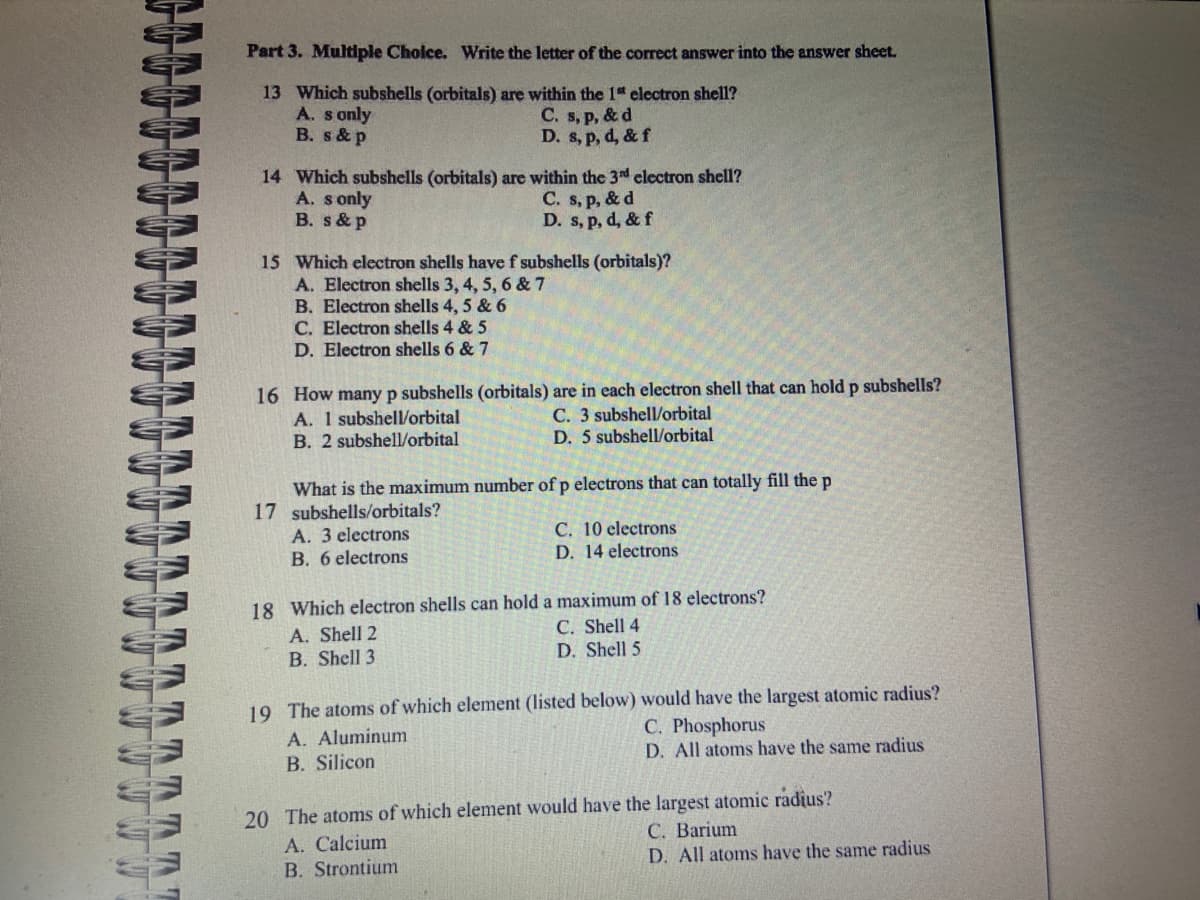13 Which subshells (orbitals) are within the 1ª electron shell? C. s, p, & d D. s, p, d, & f A. s only B. s & p 14 Which subshells (orbitals) are within the 3rd electron shell? A. s only C. s, p, & d B. s & p D. s, p, d, & f 15 Which electron shells have f subshells (orbitals)? A. Electron shells 3, 4, 5, 6 & 7 B. Electron shells 4, 5 & 6 C. Electron shells 4 & 5 D. Electron shells 6 & 7 16 How many p subshells (orbitals) are in each electron shell that can hold p subshells? A. 1 subshell/orbital C. 3 subshell/orbital B. 2 subshell/orbital D. 5 subshell/orbital What is the maximum number of p electrons that can totally fill the p 17 subshells/orbitals? A. 3 electrons B. 6 electrons 18 Which electron shells can hold a maximum of 18 electrons? C. Shell 4 D. Shell 5 A. Shell 2 B. Shell 3 C. 10 electrons D. 14 electrons 19 The atoms of which element (listed below) would have the largest atomic radius? C. Phosphorus D. All atoms have the same radius A. Aluminum B. Silicon 20 The atoms of which element would have the largest atomic radius? A. Calcium B. Strontium C. Barium D. All atoms have the same radius
13 Which subshells (orbitals) are within the 1ª electron shell? C. s, p, & d D. s, p, d, & f A. s only B. s & p 14 Which subshells (orbitals) are within the 3rd electron shell? A. s only C. s, p, & d B. s & p D. s, p, d, & f 15 Which electron shells have f subshells (orbitals)? A. Electron shells 3, 4, 5, 6 & 7 B. Electron shells 4, 5 & 6 C. Electron shells 4 & 5 D. Electron shells 6 & 7 16 How many p subshells (orbitals) are in each electron shell that can hold p subshells? A. 1 subshell/orbital C. 3 subshell/orbital B. 2 subshell/orbital D. 5 subshell/orbital What is the maximum number of p electrons that can totally fill the p 17 subshells/orbitals? A. 3 electrons B. 6 electrons 18 Which electron shells can hold a maximum of 18 electrons? C. Shell 4 D. Shell 5 A. Shell 2 B. Shell 3 C. 10 electrons D. 14 electrons 19 The atoms of which element (listed below) would have the largest atomic radius? C. Phosphorus D. All atoms have the same radius A. Aluminum B. Silicon 20 The atoms of which element would have the largest atomic radius? A. Calcium B. Strontium C. Barium D. All atoms have the same radius
Chemistry by OpenStax (2015-05-04)
1st Edition
ISBN:9781938168390
Author:Klaus Theopold, Richard H Langley, Paul Flowers, William R. Robinson, Mark Blaser
Publisher:Klaus Theopold, Richard H Langley, Paul Flowers, William R. Robinson, Mark Blaser
Chapter6: Electronic Structure And Periodic Properties Of Elements
Section: Chapter Questions
Problem 41E: Consider the orbitals shown here in outline. (a) What is the maximum number of electrons contained...
Related questions
Question

Transcribed Image Text:Part 3. Multiple Choice. Write the letter of the correct answer into the answer sheet.
13 Which subshells (orbitals) are within the 1st electron shell?
A. s only
C. s, p, & d
D. s, p, d, & f
B. s & p
14 Which subshells (orbitals) are within the 3rd electron shell?
A. s only
C. s, p, & d
B. s & p
D. s, p, d, & f
15 Which electron shells have f subshells (orbitals)?
A. Electron shells 3, 4, 5, 6 & 7
B. Electron shells 4, 5 & 6
C. Electron shells 4 & 5
D. Electron shells 6 & 7
16 How many p subshells (orbitals) are in each electron shell that can hold p subshells?
C. 3 subshell/orbital
D. 5 subshell/orbital
A. 1 subshell/orbital
B. 2 subshell/orbital
What is the maximum number of p electrons that can totally fill the p
17 subshells/orbitals?
A. 3 electrons
B. 6 electrons
C. 10 electrons
D. 14 electrons
18 Which electron shells can hold a maximum of 18 electrons?
A. Shell 2
C. Shell 4
B. Shell 3
D. Shell 5
19 The atoms of which element (listed below) would have the largest atomic radius?
C. Phosphorus
D. All atoms have the same radius
A. Aluminum
B. Silicon
20 The atoms of which element would have the largest atomic radius?
A. Calcium
B. Strontium
C. Barium
D. All atoms have the same radius
Expert Solution
This question has been solved!
Explore an expertly crafted, step-by-step solution for a thorough understanding of key concepts.
Step by step
Solved in 2 steps with 2 images

Knowledge Booster
Learn more about
Need a deep-dive on the concept behind this application? Look no further. Learn more about this topic, chemistry and related others by exploring similar questions and additional content below.Recommended textbooks for you

Chemistry by OpenStax (2015-05-04)
Chemistry
ISBN:
9781938168390
Author:
Klaus Theopold, Richard H Langley, Paul Flowers, William R. Robinson, Mark Blaser
Publisher:
OpenStax


Chemistry
Chemistry
ISBN:
9781305957404
Author:
Steven S. Zumdahl, Susan A. Zumdahl, Donald J. DeCoste
Publisher:
Cengage Learning

Chemistry by OpenStax (2015-05-04)
Chemistry
ISBN:
9781938168390
Author:
Klaus Theopold, Richard H Langley, Paul Flowers, William R. Robinson, Mark Blaser
Publisher:
OpenStax


Chemistry
Chemistry
ISBN:
9781305957404
Author:
Steven S. Zumdahl, Susan A. Zumdahl, Donald J. DeCoste
Publisher:
Cengage Learning

Chemistry: An Atoms First Approach
Chemistry
ISBN:
9781305079243
Author:
Steven S. Zumdahl, Susan A. Zumdahl
Publisher:
Cengage Learning

Chemistry: Principles and Reactions
Chemistry
ISBN:
9781305079373
Author:
William L. Masterton, Cecile N. Hurley
Publisher:
Cengage Learning

Chemistry: The Molecular Science
Chemistry
ISBN:
9781285199047
Author:
John W. Moore, Conrad L. Stanitski
Publisher:
Cengage Learning